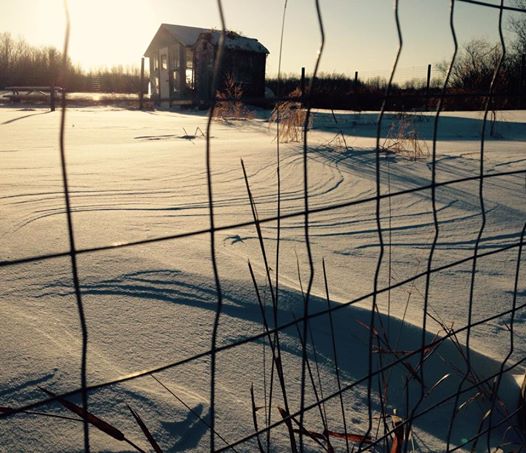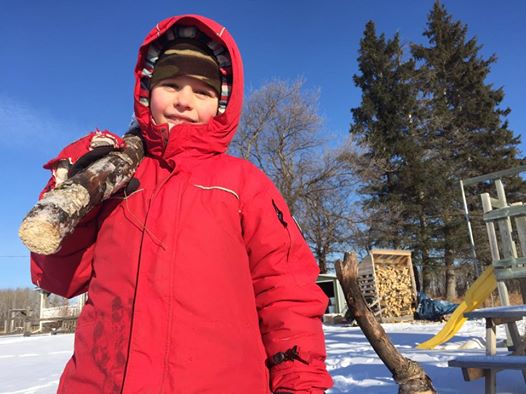
If you’re going to get a bonfire ready for the weekend, you’re going to need the best firewood gathering team.
Day 34
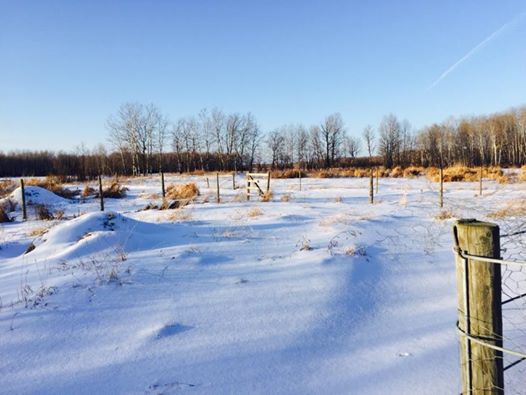
A little bit more sunshine each day means we have a little more time to make plans for the summer in areas like this that are just waiting for fencing and animals.
Day 33
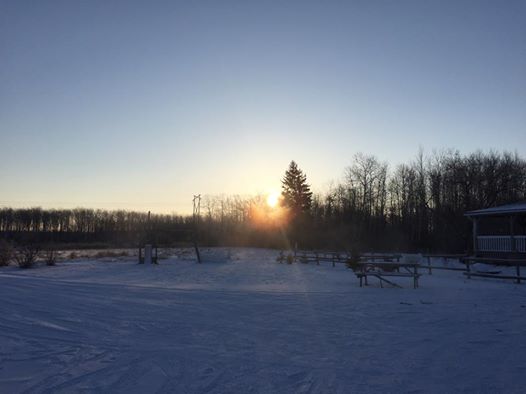
There really is nothing like a prairie sunrise.
Day 32

A neighbour dropped off a treat bale for the goats. It seems like a great day to fill the outdoor feeder for them.
Day 31
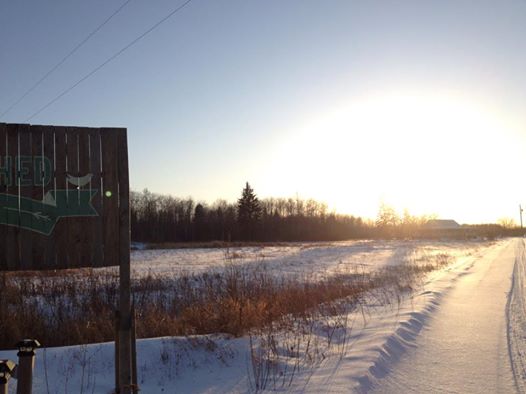
Sometimes, the whole farm seems to reflect the glow we feel from living here…
Day 30
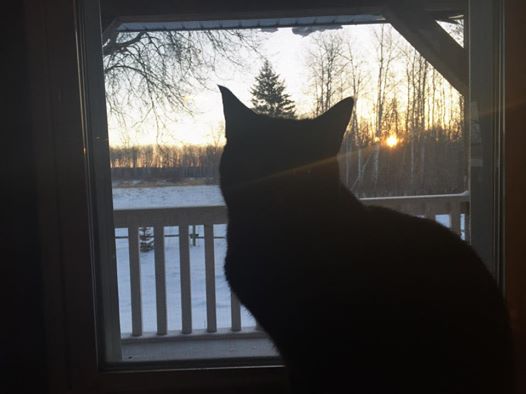
This morning, even the cat paused to appreciate the sunrise.
Day 29
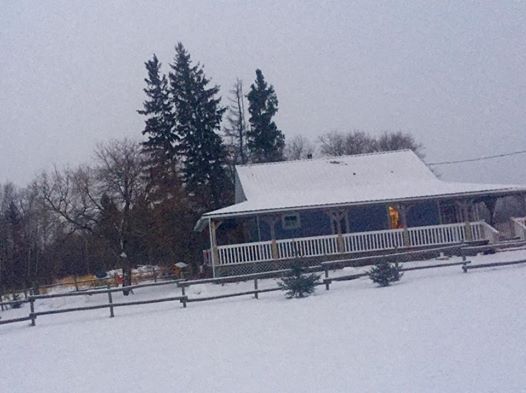
Our life here isn’t always quiet; sometimes it’s very hectic.
It slowed down for a bit at the end of the day so we went for a walk and we could *hear* the snow fall.
When it’s quiet, it’s like nowhere else.
]]>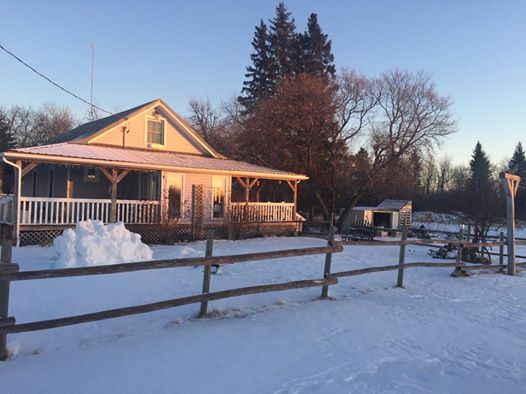
It was such a bright, sunny day today. We love how the setting sun lights up this side of the house so it glows.
Day 27
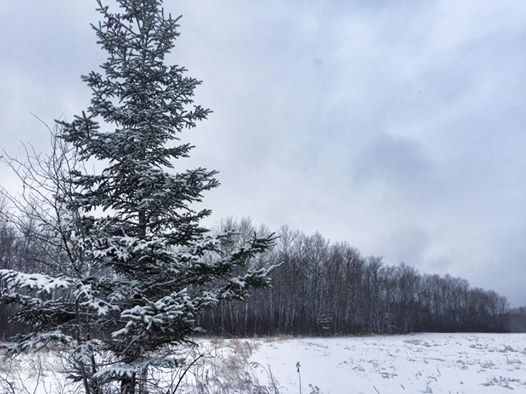
A fresh blanket of snow on everything looks very nice today.
Day 26
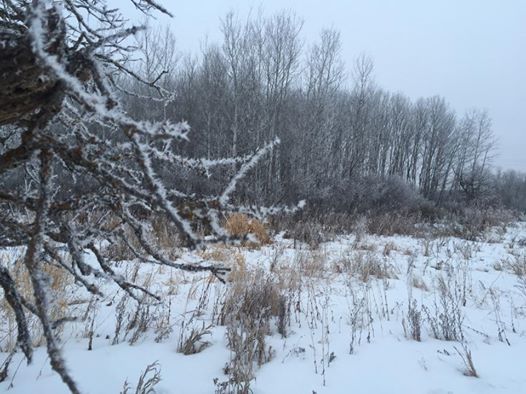
Beautiful hoarfrost everywhere on the farm today.
Day 25

As a follow-up to the photo of our much-loved dogwood last week, we’ve had enough snow melt that we can see the branches on the ground from our Solstice celebration last month.
Day 24
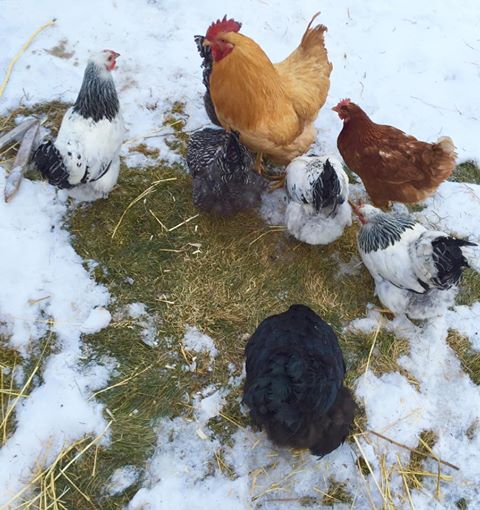
Just as we are making plans for pastured chickens this summer, our chickens found a patch of grass today to peck.
Day 23

What would our farm be without Rex. He is a great protector for the animals and the kids.
Day 22
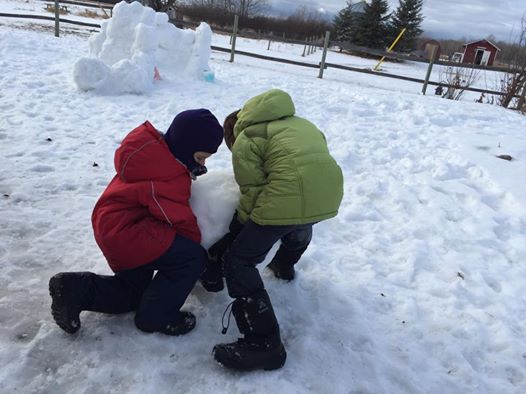
Warm January afternoons are for moving big snowballs from old snow forts to the new snow fort.
]]>We had very mild weather, so we found a lot to do outside each day. From goats to chickens to birds at the feeder, this was our week.
Day 21

Friends and family have been known to have a nap under the big dogwood on a warm summer day.
Day 20
Our farm dog Rex has had a very cautious introduction to the goats. Their time together can be best summarized as glaring at each other through the fence.
Today Peach decided to go for a closer look while the rest of the herd decided to move on.
Day 19
Another mild day so the chickens came outside for a visit.
Day 18
Some days it’s really nice out so you move bales for the goats to climb.
Our two goats that are bred are growing quickly. It won’t be long before their kids are on the way.
Day 17
Hauling wood is always worth the effort. There is nothing quite like our home heated by the wood stove all winter long.
Day 16
Every day on the homestead is an opportunity to make a new fort using found items…
Day 15
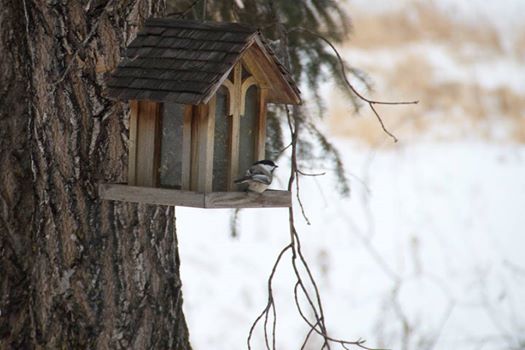
We took time to fill the bird feeders today. There is always something comforting about seeing signs of life all winter long.
]]>Day 14
Taking a break in the afternoon to collect eggs — and hug chickens — is always important.

Day 13
With this much grass still showing in mid-January, it’s hard not to think about what will start growing everywhere this spring.
Day 12
Another beautiful sunrise greeted us today.

Day 11
Sometimes having company is all you need to get outside in the winter. A few handfuls of oats doesn’t hurt either.

Day 10
We took a bit of time to cross-country ski today. Having ski trails here makes it easy to get out together.

Day 9
With the later sunsets come earlier sunrises.

Day 8
Even in early January, the days are getting longer and it feels so good.

Day 7
While the chickens were curious, they weren’t quite brave enough to be outside today for very long.
We raised our egg layers from day-old chicks and now they are laying eggs for our family. It’s been an amazing journey to watch them grow.

Day 6
While everyone loves summer when everything is lush and green, being out here has shown us how beautiful winter is too. There’s something about the sun setting behind the bare poplars that gets us every time.
Day 5
Even on a cold, windy day, it feels to get outside in the sunshine for a while. Our goats are happy for the company as well.

Day 4
We’re always amazed by what memories are triggered by a walk around the farm. What once was another opening in the woods is now a reminder of the first spring day that we took books and read while sitting on fallen trees.
This clearing is one of our favourite places out here: it’s not far from the house and once you’re there you’re immersed.

Day 3
One family’s waste is another chicken(s) treasure…No guilt for wilted greens. Our flock of heritage breed laying hens will transform these nutrients into super-powered eggs for our family and a few others…
Day 2
The garden and greenhouse lie dormant in the deep freeze of a Prairie winter. Everything rests…
Day 1
We’re starting a little project this year. Every day we’ll share a picture with you that represents some aspect of the beautiful and simple life we enjoy at Nourished Roots. We’re starting with a shot of this trio of extraordinary trees that provide so much for us – boughs for a winter solstice celebration. Medicinal pine pollen. Shelter from the wind.

]]>
Have you ever wondered what the difference is between canning food and culturing, or fermenting it?
There are many differences that you might want to consider…and you’ll learn more about what’s right for your family over time.
As a homesteader, I have a diversified food preservation strategy and I both can and ferment.
So let’s start with canning.
There are many benefits to canning- including that you get to preserve the harvest and stretch some of that local, sustainable yumminess throughout the winter. No one, and I mean no one, complains when you open some applesauce, canned garden tomatoes or zucchini relish in February.
But the process of canning itself requires special knowledge, skills, and equipment. It’s a bit cumbersome and tedious. Particularly if you are standing over that hot water bath sterilizing and sealing jars in an August heatwave.
The process itself requires immersing your filled jars in a ‘hot water bath’ for a set amount of time. This process seals the jar and it kills any the high temperatures kill any micro-organisms that are present and might cause spoilage. That is a double-edge sword though, as many of those micro-organisms boost our health and digestion. So rendering your food ‘dead’ isn’t necessarily optimal.
Culturing, or fermenting, on the other hand, requires no special tools (unless you think of a jar as a special tool). Your equipment needs to be clean, not sterile. And it takes minutes to make. The outcome is a food that is at once tasty, medicinal, and healing.
It’s the traditional food skill that people adore learning and I adore teaching in my classes and traditional foods teacher training.
It’s only drawback (in my mind) could be that it requires cold storage. Of course that wasn’t an issue when households all had a cold cellar to overwinter their garden harvest and preserves. Today, the fridge has taken its place and one can find their space a bit limited. But a cold floor in the basement can also do the trick in a pinch.
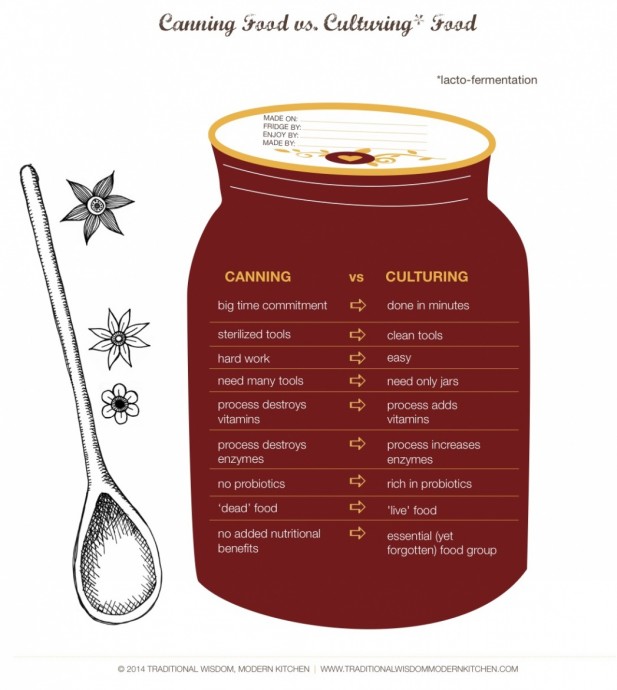
So what *is* lacto-fermentation anyhow?
Lacto-fermentation has been used by people around the world to preserve food long before freezers, pressure cookers and canners ever made their way into our lives…
Sugars and starches are converted into lactic acid. This is the work of lactobacilli present on the outside of most foods- particularly those on, or near the ground. Lactobacilli inhibits putrefying bacteria, thereby acting as a natural preservative.
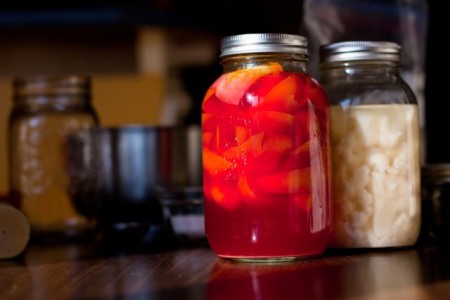
In fact, under the right conditions, fermentation will occur naturally in many foods. Humans learned to harness this natural preservation method thousands of years ago.
Why ferment?
Fermentation has been used by people around the world to preserve food, enhance its flavour, and boost its nutritional value.
The process actually encourages the growth of beneficial bacteria that aid our digestion and keeps our digestive tracts populated with essential beneficial micro-flora…
There is a growing body of evidence that many diseases and imbalances are directly linked to an imbalance in the gut. And that has led researchers to call ferments a ‘lost food group’.
We now know that you would be hard-pressed to find a group of people without a corresponding fermented food that is rooted in their tradition. Think: sauerkraut (Ukrainian), Kimchi (Korean), Miso (Asian), lassi and idli (Indian), viili yogurt (Nordic), and skyr (Icelandic).
Unfortunately, many of these foods have disappeared from family meals altogether and what’s found on grocery store shelves is mostly a mass-produced, pasteurized (dead) version…
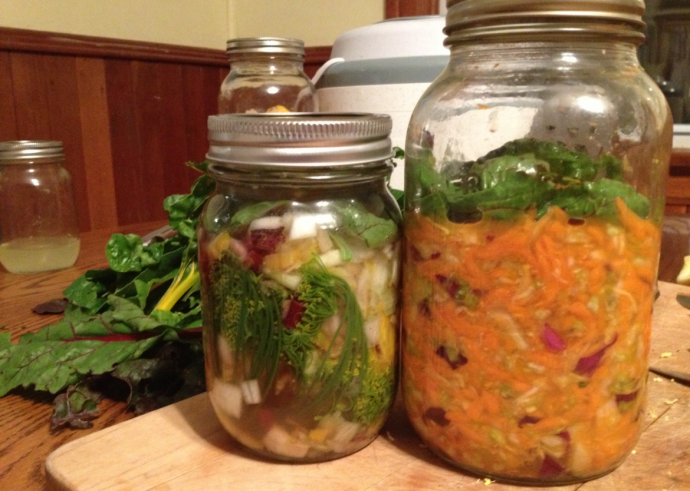
Luckily, it’s not hard to make your own ferments. And, what’s even better, is you can tailor what you make to your taste – whether that’s shredded daikon radish, sweet bread and butter pickles or a tangy carrot and ginger kraut.
So if you haven’t already tried fermenting your own food, it’s time to take the leap. It’s simple, tasty and delicious. It’s full of important probiotics and it exponentially increases the nutrition of your food.
What’s not to love?
Meet the author…
Adrienne Percy stewards the land at Nourished Roots with her family. She has a special love for traditional foods and is the founder of Traditional Wisdom, Modern Kitchen– a traditional foods teacher training program.
Find out how you can take the Level I class to learn traditional foods skills or Level I + II to become a certified traditional foods teacher.
The next class starts May 22and is the last session of 2014.
]]>
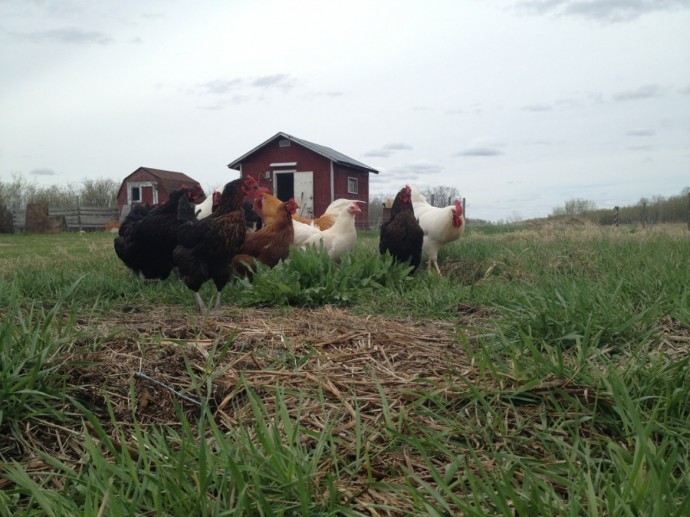
Ever heard of an ‘artist in residence’ program? This is the *farm* version 
If you can’t move out of the city (yet), but want to spend the growing season in the country raising your own food, this just may be your chance 
What it’s all about….
Would you like to have your own CSA? Raise pastured poultry? Be a part of a growing modern homesteading movement?
Our “Planting a Seed” Program was created just for you…
Planting a Seed recognizes that there are plenty of you who dream of having your own farm. But maybe you just are not ready to leave your current home base (yet). Maybe you need more experience or want to really try this on before making the leap (permanently).
But how do you gain experience, flex your unique style of gardening/farming chops, and maybe make a bit of cash…
Introducing the :
Planting A Seed Program
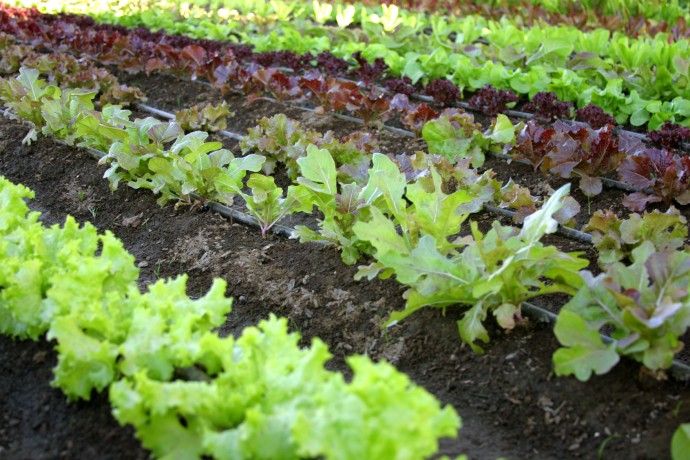
What: An opportunity for 1-2 motivated people to come swap LAND for LABOUR and be a part of creating Manitoba’s first homesteading education and re-skilling centre while running your very own mini-farm op on site through the 2014 growing season.
Where: At Nourished Roots- a 320 acre property in the province’s Interlake region- just 75 km (about 40 minutes) north of Winnipeg near Fraserwood, Manitoba.
Does this sound familiar?
You:
- Drool at the thought of spending the summer in the country, outside, with your hands in the dirt (because your heart is already there)
- Get excited about heirloom seed, permaculture design and re-skilling the way the rest of the population gets excited about a new episode of Mad Men
- Are fun, open-minded, and are a down-to-earth dreamer
With ‘Planting A Seed’ you get access to:
- Two large garden plots (i.e you don’t have to break ground).
- Pasture (for example, if you would like to have pastured poultry etc)
- The garden tools that are on site
- An opportunity to meet and connect with a growing community of young farmers and homesteaders in the area
- An opportunity to work and learn with a family building an alternative model of the modern homestead
In exchange for:
- 8-10 hours of labour/week
- 1 full share in the CSA (or, if you are not offering a CSA and just planting for yourself, a pre-agreed portion of harvest about equal to one CSA share)
You bring:
- Enthusiasm/great work ethic/honest and positive attitude
- Great ideas about sustainable farming & gardening
- Your own accommodations (camping trailer/tent etc)
- Your own food
- Your own seeds/plants/soil amendments etc
Interested? Contact us here
Deadline for application is February 28
A little about us:
Philosophically:
Nourished Roots is all about connecting people with the skills and inspiration they need to build community, to grow and eat good food, and to raise children who are nourished- body, mind and soul.
Practically:
Nourished Roots is a 320 acre farm and re-skilling site right smack dab in the middle of Canada. It is the home of Canada’s DIY Homesteader Festival…
About the family behind Nourished Roots

Adrienne and Trevor traded in fancy shoes and power lunches for galoshes and preserves years ago.
Now you’ll find them and their two children building compost bins, hauling wood, turning soil and picking eggs. That is of course when they’re not in the kitchen cooking up delicious recipes made using traditional food prep methods…
Adrienne teaches workshops on traditional foods (with lots of special love for fermentation).
]]>
It doesnʼt seem like that long ago, I was sitting on the 7th floor of a downtown office building – gazing out the window at the big, blue prairie sky and the brilliant sunshine, and thinking, “What am I doing inside, when it looks like that outside!?”
Not only was it a stunningly, beautiful Manitoba summer day, but I was *freezing*. My teeth were chattering and my hands were cold.
The ʻclimate controlledʼ building meant I was wearing the same cardigan in the summer …as I had been wearing most of the dreadfully frigid winter.
It was no wonder that I felt completely…disconnected.
Recognizing how unnatural my day-to-day existence had become was part of what propelled me to trade in a pinstripe suit for galoshes and gardening. To make the move from city to country. And to start the journey back from deskilled- to reskilled.
Out on the land today, I wonder how so many people are able to bear it for so long. Unfortunately, many people canʼt quite define where their stress is coming from. Itʼs just always there, as a low (maybe high) grade anxiety.
Many years ago I had a co-worker come and tell me that he had to go to the hospital for having an anxiety attack, “for no reason.”
But was it really no reason?
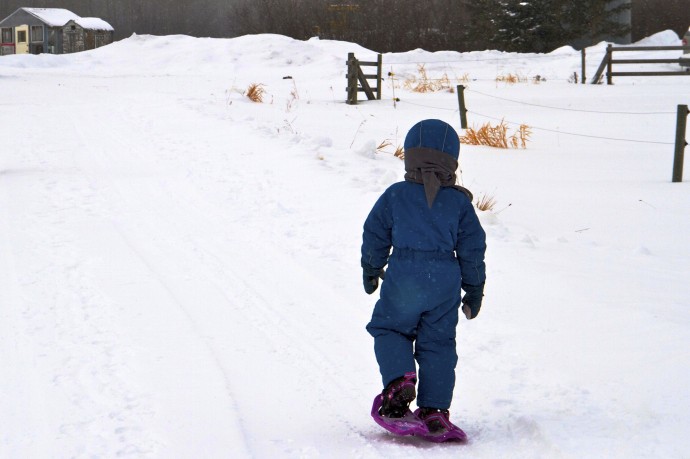
Although itʼs a relatively new label, Nature Deficit Disorder is defined by a lack of connection to nature.
Its ʻsymptomsʼ are said to include:
• increased feelings of stress
• trouble paying attention
• feelings of not being rooted in the world
Is it really that far-fetched that this disconnect is causing mental and physical illness?
As humans, we are still hardwired to pay attention to the seasons and the weather…That primal part of us that signals, ʻit is time to be outside. It is time to hunt and gather. To frolic. To turn our faces to the sun.ʼ Despite the modern conveniences of air conditioning, lights, ipads and *year-round* strawberries….that part of us lives on.
Like, a child tugging at the pant leg. Asking you to *listen*…
Hardwired to connect
It wasnʼt long ago, that the human animal lived just as closely to Mother Earth as the other living beings that populate our planet.
And Mother Nature dictated what we did *and when* we did it.
Day-to-day and season-to-season…People rose with the sun, and wound down when darkness fell.

There was no electricity to power lights, television and computers to keep us working and browsing, long after our natural biorhythms had told us it was time to rest and restore with a good nightʼs sleep…
Our inclination to live in sync with the seasons is apparent throughout history and in our connection to the food we are designed to eat…
Many people have heard of the ʻHarvest Moonʼ- a moniker stemming from the Old Farmersʼ Almanac. But each of the moonʼs 13 annual cycles had names as well. And while they varied around the world, they most often described the food or living situation that dominated that period of time.

For example:
• Corn Moon: fell on the cusp of summer and fall when corn stood tall in the fields (Celts
and many Native American cultures)
• Moon When Salmon Return to The Earth: This name is attributed to the Saanich (or
Wsanec people) who actually had several names for the period when specific salmon
(such as Coho) returned.
• Blood Moon or Hunterʼs Moon: This name has its roots with indigenous people of the
Eastern Woodlands and falls mid-autumn, when the air is growing colder and the
northern dwellers would work to ensure their store of meat would last the winter.
• Snow Moon: Is from sixteenth century England. This is when autumn is becoming
winter. The first snowfall could be expected at any time. Waterways and reservoirs
start to freeze. Could be the last opportunity to preserve food
• Moon of Long Nights: This is the time when winter solstice approaches. In some
regions, dawn and dusk occur at almost the same time. A time of darkness.
• Hunger Moon: Coincides with the late winter lunar cycle and is named such because,
as you might have guessed, food was often in scarce supply…
• Sap Moon: A name with Ojibway roots. “Although snow and ice still cover the ground,
the promise of spring stirs the land. Sap begins to rise up through tree trunks…”
Source: Full Moon Feast, Jessica Prentice
Reconnecting- one mouthful at a time…
Working on our relationship to food, can help us recover our relationship to nature. Just *try* to plant a garden, for example, and not notice just a *few* more details about the nuances of each season. Tender shoots, rapid growth, flowering and fruiting. Decay and dormancy.

Old sayings like, “make hay while the sun shines” take on added meaning. The fairly narrow window for each fruit, vegetable and herb that needs to be picked and processed, comes in rapid succession. Wild mushrooms. Berries. Peas. Stinging nettle. Spinach. Beans. Corn. Rosehips….
Enjoyed at their peak deliciousness. Juicy strawberries picked and eaten from the plant. Sweet peas shelled by tiny hands. And carrots so tasty they simply cannot be compared to supermarket fare…
And while there is often a sense of urgency that comes with a lifestyle more in sync with the seasons (for example during periods of planting, growth and harvest)- there is also a sense of groundedness and connection.
Again, the prose of Jessica Prentice comes to mind…
“…eating winter produce in winter helps me reconnect with the Earthʼs rhythms and with the seasonal reality of my forebears. It reminds me that to everything there is a season and time. It helps me let go of my desire to have whatever I want, whenever I want it, instantly. It helps me appreciate that what I have been given and to accept it gratefully.”
As part of a new wave of ʻmodern homesteadersʼ we have come to realize that attention to, and attunement with, seasonal rhythms could mean the difference between a great harvest (and a poor one), working in the flow (or against it), and even life and death. It can dictate how and when we connect with others and, as I teach in my classes, the difference between good or- poor health.
Homesteading observation
I have often wondered what unnatural lighting does to *human* biorhythms and hormones. Especially after observing how the ʻsimpleʼ act of turning a light on in a chicken coop can propel hens to lay eggs throughout the winter- a time when, left to their own devices, they would be dormant- saving their baby-making energy for spring- a time of natural fertility.

In the book, “Lights Out: Sleep, Sugar, and Survival”, Anthropologist T.S. Wiley muses that artificial lighting responsible for the rise in degenerative diseases such as obesity, diabetes, cancer and heart disease.
The reason, she says, is that when we stay up after the sun goes down (using artificial lights, watching tv and and using computers), we disrupt our natural hormone function and push our bodies into a state of ʻperpetual summerʼ. This, she says, is at the root of our sugar and carbohydrate cravings because those nutrients were primarily available to hunter-gatherers during the summer.
So improving your health could be as simple to making a commitment to turn off the computer (and turn out the lights)…
Seasonal eating and health
It is likely, that, more often than you think, your body gives you signals that it is *still* in tune with our ancestral food wisdom…
For example, I find that I can hardly bear to eat a salad in the middle of the winter. But give me a bowl of hearty, piping hot soup or a root vegetable stew and I am content.
Come spring, I am eager to eat sprouts and shoots.
In the summer, it seems easy to skip right over lunch in the heat of the day (or to keep it very light). Supper could be as simple as a plate of fresh vegetables, steamed beets, cheese and sourdough bread.
By eschewing farmersʼ markets for supermarkets, and slow food for convenience food, many people have lost their ability to heal through intuitive and seasonal eating. But that can be reclaimed – whether you live on a homestead or in a condo.
Take the time to learn what is in season. And maybe even to grow something yourself. Preserve one thing this year, whether that is by freezing, fermenting, canning or drying it.
Take a walk in nature, Plant a garden, Turn off the lights. Take part in a seasonal (not commercial) celebration.
And disconnect from your screen time to connect again with life…
*This article was originally printed in the fall edition of Interlake Arts, Life and Leisure Magazine….
]]>
Joy and tears.
Progress and setbacks.
Challenges and solutions.
2013 was a year of getting to know this land. The way the rain falls. Then trickles, or flows, across the yard and fields. Where the wind whispers, and where it howls…
We learned about ourselves. As a family, and as individuals.
We learned that we need less than we thought to be happy.
We learned that the sweetest moments almost always happen when we are outside, together. We learned that self-care and self-development must be nurtured with the same care and forethought as the crops you hope to harvest…
The year’s highlights did not include the things a materialistic society might define as important…
The moments that made our hearts sing were all about connection to each other, friends and community, and to nature.
They were the times when we watched the kids savouring a freshly-pulled carrot from the garden. Or when they skipped happily through a field of wildflowers. Or when we looked up at a night sky full of blazing stars…
My husband and I agree, those were the times that made our hearts feel like they might burst with love and pride. Those were the times when we thought: “This is it. This is what it’s all about.”
Here is what some of those moments looked like in 2013….
On a little homestead on the prairies, the year might just start in the snow…
Often outside, in a nearby thicket of trees. Drinking hot chocolate in the woods…

And favourite pastimes might be simple…like leaping across bales of hay with friends in the crisp, wintery air…

Of course, there are plenty of unexpected sights too. Like beloved laying hens who so dislike the snow that they have managed to flap their way to the top of a coop…
This is Mavis. She brought nourishment- and lessons about life and death on the farm…She was the kids’ favourite. And the first of our chickens to die…

Almost from the start, we got sweet on sunsets. From the dining table, or the edge of the wraparound porch, this is what we see…

Brilliant streaks across the prairie sky. It sets our hearts soaring with wonder…

The winter went on forever. Until we just couldn’t wait any longer to indulge in spring’s pleasures…

And then it came to stay. Spring emerged in her fertile wisdom. We were ALL ready to range freely again…

Winter had not been a time of idleness. As we went inward, an idea had germinated and taken root.
The DIY Homesteaders’ Festival was all about a desire to give back. It was about cooperation and vision. It was a team effort that culminated on June 1st with more than 300 people flocking to the land we call home- all to re-skill and reconnect.

They learned about everything from raising chickens to beekeeping…

From making soap to spinning fibre…
And of course, they were nourished with delicious, local, food from amazing farmers and artisanal bakeries…

In the days following the festival, the kids celebrated a birthday with some unexpected guests.

Wild mallard ducklings nursed to life by the little missus, who found abandoned eggs scattered throughout the yard.

They kids took to nurturing them like a duck takes to…well, you know how the story goes.
This was their first swim…and the day the conservation officers came to pick them up and take them to their new home at a wildlife rehabilitation centre…

2013 was a summer of learning and building. We hosted a cob oven workshop with the talented folks of Urban Eatin’ Gardeners Worker Coop, leading the way.


Playing in the mud, sand and straw – it was a 9-year old’s dream…The finishing touches involved adorning the hearth like a beloved mother’s full belly. She was glowing, round and jewelled!

I (Adrienne) couldn’t help but to keep creating in my own way. Sometimes out of necessity. Like this simple, homemade electrolyte drink that restored cob oven workshop participants toiling in the blazing sun.

We learned just how abundant this land is. With a skilled wildcrafter as our guide, we learned how to identify, harvest and prepare the wild food and medicine that grows here…

It felt so beautiful to see our friend, and wild edible workshop host, Laura Reeves, pass some of those gifts to the next generation. It was a highlight of the summer when she spent an afternoon with our fearless 6 year old who shows a knack for all things herbal.
Here they are, about to leave on a 3 hour trek through field and forest. A time of eating wildberries and inhaling the sweet, cream soda-like scent of milkweed…

And of course, marvelling at butterflies that danced across fields of goldenrod…

The exploration continued throughout the summer. Every day was a reminder that beauty is everywhere, Even hidden among the gravel.

We learned that all the animals like to have fun. And that bale jumping isn’t just a winter activity. Or just for kids…

Sometimes we just got plain silly. And had debates about whether to call this: ‘Dog tired in the shade’. Or ‘Tired dog in shades…’

Then came the gifts of harvest …

…and its lessons. Like the importance of calculating your family’s food needs…
And how much zucchini is too much? (Answer: It all depends whether you have enough interesting zucchini recipes…)

The house filled with the scent of herbs drying for winter teas…

The bounty of harvest came from our own land and from that of neighbours. Like the Kerr apples from farmer Betty Kehler’s orchard…that make the most undeniably delicious, cider…

Processing harvest was a family affair. Some gadgets were so very much fun. And made things so much easier!

Eventually, the promise of summer blew into the beauty of fall…

We all felt a natural inclination to slow down…

And to learn…A three day goat school inspired us to dream of all things goat. It was clear the kids loved the kids…

And then Mother Nature let us know what was coming….

The first snowfall gave us a hint of what this winter would be like…

And although it’s been bitterly cold, we’ve basked in the warm embrace of celebrating the year with friends and family.

And with the longest night of the year behind us yet again, we’ll turn our faces to the sun and to the promise of the year ahead…

]]>
And it’s just so simple to make that there’s really no good reason to buy it!
I’ve tried many recipes over the years, and what makes my palate sing with happiness is a bit of citrus in the mix.
The sweetness of say, orange, pairs beautifully with the tartness of the cranberries and generally seems to cut the amount of sweetener required to make a sauce everyone raves about…
So here’s how I do it. Keep in mind I’m “A-little-bit-of-this-a-little-bit-of-that” kind of cook so feel free to adjust to your own taste!
Homemade cranberry sauce
Ingredients
- About 2-3 cups of fresh (organic) cranberries
- 1/2 c organic *white sugar
- 2 tbsp lemon juice
- juice of 2-3 small-medium size orange
- About 1/2 -1 tsp orange zest
- 1/2 c water
*Yes, cranberry sauce is a condiment (used sparingly) so I decided to use sugar in order to keep the sweetener neutral and the cranberry and citrus flavours most pronounced. However, feel free to use honey or maple syrup if you like. Those will change the consistency and taste of course, so putter around with your ingredient ratio if you’re inclined to do so.
Adjust your liquids accordingly as well when using a liquid sweetener…
Method:
Add cranberries and water to the pot. Simmer on med-low heat for 10-15 minutes. Add remaining ingredients and simmer until sauce is the consistency you like. Stir once in a while so mixture doesn’t stick to bottom of pot.
Taste test a dollop of the sauce on a spoon to see if it’s sweet enough for your taste.
Once it’s done, simply allow to cool and store in fridge!
Making extra? Here’s a few ways to preserve it…
1. Ferment it.
Pour the sauce into a jar and add about 1/2 tsp salt and 3 tbsp whey. Screw lid on tightly and allow to ferment/culture overnight before transferring to cold storage.
2. Can it.
I would suggest using pint jars…Follow standard canning instructions that can be found online.
3. Freeze it.
You can freeze in wide mouth jars (if you leave at least 1-2 inches headspace for expansion). You can also freeze in ziploc freezer bags.
p.s: Have extra fresh cranberries left over? Throw the in the freezer to use later. They freeze beautifully!
Do you make your own cranberry sauce? Would you try it? Anything you add to your cranberry sauce that you love?
]]>







